Vol 4 No. 28 TROPIC LIGHTNING NEWS July 14, 1969
Index
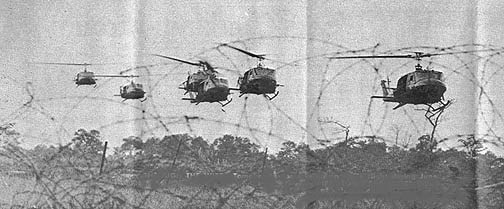 |
| THROUGH THE WIRE - Tomahawks come in on an eagle flight during June. (PHOTO BY SGT ROGER WELT) |
Lightning Begins Long, Hot Summer
Charlie Smoked Out
When General Creighton W. Abrams awarded Presidential Unit
Citations to five battalions on June 13, he said that the men of the 25th stood
tall and looked proud - and with good reason.
Individually and collectively, the actions of the men of the Tropic
Lightning Division in June continued to support that evaluation.
The first major confrontation in the AO occurred on June 5 and 6 at
Fire Support Base Crook, eight and one-half miles northwest of Tay Ninh City.
Those two days of intense battle accounted for over 400 NVA killed in the area
surrounding the fire support base.
After avoiding contact for two weeks, the enemy finally came out of
hiding on June 4. The fortnight Charlie spent in his hole must have made
him stale, for everywhere he turned Tropic Lightning was there to hit him.
Manchus from the 4th Battalion, 9th Infantry engaged NVA soldiers in two battles
a few miles north of the Angel's Wing. Second Battalion, 12th Infantry,
troopers joined with elements of an ARVN unit to get a 52 body count in the
Citadel. The day-before-Crook actions cost 123 enemy lives.
Shortly after 3:00 a.m. on June 5 the NVA putsch began.
Trying in vain to reach the unreachable inner wire around Crook, the NVA
soldiers hurled themselves at the base's defenders under a screen of small
arms, automatic weapons and RPG fire. Alpha Battery, 7th Battalion, 11th
Artillery and B Company, 3d Battalion, 22d Infantry were supported by Cobra
gunships, Spookie, Shadow, artillery and tactical air strikes.
ALTHOUGH THE EAST maintains its reputation as inscrutable,
"inscrutable" would not accurately define the second NVA attack of Crook.
"Stupid" would be more like it. The methods of attack were the same.
The defense was as stout. The result was more - much more - of the same
for the enemy.
The first night of fighting, with the 77 bodies lying outside the
wire at the fire support base, was an enemy success when compared with the
outcome of the following night's fight. Three hundred twenty-nine enemy
bodies were discovered following the second Crook attack. In successive
nights of dying, two regiments of the 9th NVA Division were mangled.
A CRESCENDO for June had been reached. Though the intensity
of activity had to subside, our foe wasn't to go into complete seclusion.
On June 8, elements of the 3/4 Cav and the 4th Battalion, 23d
Infantry carried the brunt of the fighting in two separate skirmishes that cost
the enemy 51 lives. In the Boi Loi Woods on June 12, Wolfhounds of the 1st
Battalion, 27th Infantry, met an enemy force and accounted for a 23 body count.
THE MIDDLE OF June continued to produce moderate action.
Enemy activity had increased over the pace of the very early days of the month.
On the 13th, the 1st Battalion (Mechanized), 5th Infantry ambushed an estimated VC
company. The result of the Bobcat attack was one fewer platoon in that
company.
Contact for the next few days was sparse. When and where the
enemy would get his forces together were the questions.
The pre-dawn hours of June 19 supplied the answers.
AT FIRE SUPPORT Base Washington, two and one-half miles north of
Tay Ninh City, enemy sappers were detected. Immediately, flares
illuminated the flat marshland around Washington, pinpointing several squads
attempting to make their way to the wire. The fight exploded as artillery,
air strikes and Spookie zeroed in on the enemy.
THE ATTACK ON Washington was unlike the Crook action. It
lasted but two hours and was coordinated with other enemy activity. While
the Regulars were stunning the NVA at Washington north of Tay Ninh, the 3/4 Cav
and the 4/9 were meeting other large units south of the provincial capital.
THERE IS NO doubt that the objective was Tay Ninh City. But
the Cav and the Manchus provided the requisite blocking force that sent their
foe reeling away from them and from Tay Ninh.
The Tomahawks of the 4th Battalion (Mechanized), 23d Infantry swept
through the outskirts of Tay Ninh with Regional and Popular Forces, making
scattered contact.
AFTER THE ABORTIVE thrust on the 19th, the NVA crawled back to
their holes. Not until June 27 at the base of Nui Ba Den were the NVA
again met in force. That day, the Tomahawks chased their foe through a
banana grove. Ninety-four enemy died.
As July nudged June into history, Tomahawks patrolled the slopes of
Nui Ba Den. Occasionally light contact was made. In the first days of
July, attention was again directed to securing the area at the base of the
Mountain.
| When's the last time you checked your shot record? When's the last time you made that happy trek to the dispensary? Be sure to look soon. Not checking is a good way to delay your stay. |
Rats, It's a Hardship Tour
''Hey, what's for chow tonight?"
"Chicken."
"Not again. I swear that mess hall is
in a rut. I'd rather eat C-rations than see chicken again."
The above is perhaps a representation of some of the milder
criticism of Army chow. It's only natural. Everyone knows that it
is a soldier's inalienable right to complain about the food.
But the soldiers that complain the most should have been with a
reconnaissance patrol operating on the banks of the Vam Co Dong River, five
miles west of Trang Bang.
The platoon broke up an enemy dinner party by exploring a bunker in
the late afternoon. Several pots of warm rice indicated that the enemy had
made a strategic withdrawal prior to dining.
Charlie doth not live by rice alone, and the supplement to his diet
was found in a corner of the bunker.
There, crammed into a crowded cage, were 20 live rats. A
succulent delight was in the offing until the rude GIs interrupted the party.
Elements of the 4th Battalion, 23d Infantry and the 3d Battalion,
22d Infantry, swept the area.
Any questions about the chow tonight? It's chicken.
"M-m-m, outstanding."
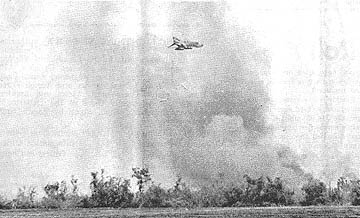 |
LETHAL LOAD - A jet streaks over enemy positions, unleashing a fiery load in support of Dreadnaught and Bobcat forces of the 2d Brigade. (PHOTO BY SP5 DOUG ELLIOTT) |
Page 2 TROPIC LIGHTNING NEWS July 14, 1969
Decorated
| SILVER STAR MEDAL | |
| SGT Ronnie L. Reddell, Co. C, 1st Bn., 5th Inf. | |
| DISTINGUISHED FLYING CROSS |
|
| MAJ Henry B. Gillespie, HHC, 4th Bn., 23d Inf. | WO1 Larry J. Turley, D Trp, 3d Sqdn., 4th Cav. |
| BRONZE STAR MEDAL (HEROISM) |
|
|
CPT Thomas Grace, Co. A, 2d Bn., 34th Armor CPT Eugene J. Johnston, Co. B, 2d Bn., 22d Inf. 1LT Thomas R. Chapman, Co. A, 65th Engr. Bn. 1LT Walter D. Farris, Co. D, 4th Bn., 9th Inf. 1LT Curtis C. McFarland, Co. B, 3d Bn., 22d Inf. 1LT Richard L. Nichols, Co. C, 4th Bn., 9th Inf. SGT Randolph Dillenbeck, Co. C. 4th Bn., 9th Inf. SGT Raymond T. Kenny, Co. A, 1st Bn., 5th inf. SP4 Joseph M. Adams, Co. A. 65th Engr. Bn. SP4 Demetrius Anderson, Co. A, 3d Bn., 22d Inf. SP4 David R. Bakken, Co. C, 2d Bn., 22d Inf SP4 David J. Bonanno, Co. C, 2d Bn., 22d Inf. SP4 Slover D. Bouknight, Co. B, 2d Bn. 22d Inf. SP4 Robert Brasington, Co. D, 4th Bn., 9th Inf. SP4 Robert L. Califf, Co. B, 3d Bn., 22d Inf. SP4 Randel D. Davis, Co. C, 1st Bn., 27th Inf. SP4 Douwe Drayer, Co. B, 3d Bn., 22d Inf. SP4 Ronald D. Flath, Co. C, Bn., 22d Inf. SP4 Phillip Kuykendall, Co. C, 4th Bn., 9th Inf. |
SP4 Raymond C. Page, Co. A, 4th Bn., 23d Inf. SP4 Dennis W. Shoffner, Co. C, 2d Bn., 22d Inf. SP4 Michael Tanner, Co. C, 4th Bn., 9th Inf. SP4 Glenn J. McDonald, Co. D, 2d Bn., 12th Inf. SP4 Edward A. Stiltner, Co C, 1st Bn, 5th Inf SP4 David Balswick, Co C, 1st Bn, 5th Inf SP4 Ralph R. Risbon, Co C, 1 st Bn, 5th Inf SP4 Bruce A. Eamick, Co B, 3d Bn, 22d Inf SP4 Doyle G. Hughes, HHC, 3d Bn, 22d Inf PFC Robert D. Bean, Co. D, 2d Bn., 12th Inf. PFC Robert P. Lahey, Co. A, 1st Bn., 5th Inf. PFC Terry Lancaster, Co. A, 1st Bn., 5th Inf. PFC Thomas Cuthbertson. Co C, 1st Bn, 27th Inf PFC Junius L. Meadows, Co B, 4th Bn, 23d lnf PFC Joe Williams, Co C, 1 st Bn, 27th lnf PFC Victor Mortis, Co C, 1st Bn, 5th Inf PFC George A. Schmitz, Co C, 1st Bn, 5th Inf PFC Michael F. Butler, Co A, 1st Bn, 5th lnf PFC Ronnie J. Lawing, Co. B, 3d Bn., 22d Inf. |
| ARMY COMMENDATION MEDAL (HEROISM) |
|
|
SSG John D. Gross, Co. A, 4th Bn., 23d Inf. SSG John W. Rife, Co. A, 4th Bn., 23d Inf. SGT Audry L. Crumb, Co. B, 2d Bn., 22d Inf. SGT Andrew Koenig, Co. A, 4th Bn., 23d Inf. SGT John F. Lawinger, Co. B, 2d Bn., 22d Inf. SGT Fred M. Shade, Co. A. 4th Bn., 23d Inf. SGT Dennis V. Siedl, Co. B, 2d Bn., 22d Inf. SP5 Bruce A. Nidell, B Trp. 3d Sqdn., 4th Cav. SP4 Byron Buie, Co. D, 2d Bn., 12th Inf. |
SP4 Paul M. Hurd, Co, C, 1st Bn., 27th Inf. SP4 Ronald G. Jones, Co. E, 3d Bn., 22d Inf. SP4 Anthony Lisa, Co. A, 4th Bn., 23d Inf. SP4 Larry K. Piltingsrud, Co. A, 4th Bn., 23d Inf. SP4 Ismael Ramon, C Trp, 3d Sqdn., 4th Cav. SP4 John E. Stiener, Co. A, 4th Bn., 23d Inf. SP4 James D. Tyner, Co. B, 3d Bn., 22d Inf. SP4 Clifford Winters, Co. A, 65th Engr Bn. |
Free Checking Account . . .
CU CHI - A checking account that's free is almost unheard of, and
one that pays five percent interest is unheard of. That is, it was unheard
of until American Express began offering that service to soldiers in Cu Chi.
The checking accounts, with free monthly statements, can be opened
at the In and Out Processing branch at the Cu Chi Finance Office. The
headquarters for the Cu Chi Branch of the American Express International Banking
Corporation will move to its own building near the post exchange on August 1.
Aside from the outstanding savings and fast service offered through
the checking account, American Express' other services will include the sale
of money orders and travelers' checks for R&R, and foreign remittance
checks.
Tentative hours in the temporary headquarters at In and Out
Processing are: Monday through Friday from 9:00 to 3:00, and Saturday from
9:00 to noon.
Edward C. Kaufer, manager, indicates that he looks forward to
extending the services of American Express to other Division bases in the near
future. Mr. Kaufer may be reached at Cu Chi 5515.
VRE Serves You
The Vietnam Regional Exchange is a valuable part of the overall
U.S. military effort. In three years it has grown into a $ 35
million-a-month business whose customers are the Free World Forces in Vietnam.
In addition to accomplishing its assigned mission of providing
health and comfort items to the servicemen, the VRE plays an important role in
the United States goal of helping Vietnam to attain a stable economy.
The Exchange helps keep the money spent by servicemen abroad in
American hands. It siphons off excess dollars servicemen otherwise might
convert to piasters, the spending of which would further overload an already
inflated economy.
Prices are based on the cost of each item and a standard markup to
accommodate operating costs. A modest "surplus" is included in pricing
to insure the sound capital structure of the Exchange Service and to generate
funds to support welfare and recreational activities.
Prices are the same at all VRE outlets. If a variance is
noted from store to store an administrative error has been made and should be
reported to the store manager.
The major share of Exchange profits - an average of 6 to 7 per cent
of gross sales - is returned to the Departments of the Army and the Air Force to
finance non-appropriated fund activities such as athletic facilities, libraries,
hobby shops, dayrooms, etc.
Beware Captured AK, MACV Says
MACV has issued a warning to American servicemen toying with the
idea of toying with captured AK-47 rifles.
GIs are warned that because of poor quality control procedures in
Communist Bloc factories, many AKs with even a slight malfunction will blow up
when fired.
MACV Directive 381-24, which prohibits use of captured weapons, is
also intended to preserve technical intelligence data that may be obtained from
the weapons.
SSAN Now In
As of the 1st of July, Social Security Account Numbers replaced
military service numbers. You should he sure that you have noted this
change of address to all of those people whom you correspond with. Be sure to
use your Social Security Account Number on all of your correspondence.
You may as well forget that old military service number as it will
no longer be used. It's just another benny from good old Uncle Sam to
keep his troopers up tight. After all, now you only have to remember one
number.
TROPIC LIGHTNING
Combat Honor Roll
Specialist 4 John T. Auker earned the honor of being named Tropic
Lightning Combat Soldier of the Week for his heroic actions while serving as a
squad leader with the 1st Battalion, 5th Infantry.
Auker won the Silver Star while working with Bobcats' reaction
force when it came to the aid of other 2d Brigade troops that were engaged in
battle. As the reaction force reached the area of contact, Specialist
Auker deployed his men and directed their fire.
When he saw a member of his squad get hit by shrapnel from a rocket
propelled grenade, Auker advanced through the enemy fire to aid his comrade.
While placing heavy fire on the insurgents, he carried the wounded soldier to a
secure area for medical treatment.
Quickly he returned to his squad and secured several hand grenades.
In the midst of devastating enemy fire, Specialist Auker assaulted the enemy RPG
emplacement and singlehandedly destroyed the position and its occupants.
He then returned to his squad and directed his men in a covering maneuver so
that the remaining wounded could be evacuated.
The success of his squad's mission was due in large part to
Auker's dedication to his fellow soldier and his gallantry under fire.
Tropic Lightning Tots
The Commanding General Welcomes
The Following Tropic Lightning Tots
To The 25th Infantry Division – As
Reported By The American Red Cross.
Born To:
| SP4 James J. Staab, 2d Bn, 14th Inf, a boy, June 10th. SP4 Robert H. Moderow, Division G-5, a daughter, June 14th. SP4 Ronald L. Norton, 1st Bn, 5th Inf, a boy, June 15th. SSG Donald Green, 2d Bde, 25th Div, a daughter, June 15th. WO1 Curtis J. Edwards, 25th AVN Bn, a boy, June 16th. SP5 Robert E. Ferguson, 725th Maint, a daughter, June 18th. SSG Timothy Rhodes, 25th ADMIN Co, a daughter, June 19th. CPT Jack C. Trapp, 25th AVN Bn, a boy, June 20th. SP4 William A. Milton, 94th Maint Bn, a daughter, June 20th. CPT John P. Newton, A Btry, 13th Arty, a daughter, June 20th. SP5 Robert C. Christie, 25th ADMIN Co, a boy, June 21st. CPT Richard L. Campbell, 25th AVN, a daughter, June 21st. PFC Roger L. Peterson, 3d Bn, 13th Arty, a boy, June 22d. 1LT Larry A. Trexler, 4th Bn, 23d Inf, a daughter, June 22d. SP4 Richard Harris, 1st Bn, 27th Inf, a daughter, June 22d. SP4 Vernon Panetti, 65th Eng, a boy, June 24th. PFC Michael Romanoff, 341st AVN. DET, a daughter, June 25th. PFC James J. Moneypenny, 65th Eng, a daughter, June 26th. SP4 James D. Richardson. Division G-3, a daughter, June 27th. SP5 John Charles Conati, 125th Sig Bn, a boy, June 27th. 1LT Eugene T. Napoli, HHC Band, a daughter, June 27th. 1LT Jackie Crowder, 2d Bn, 12th Inf, a boy, June 27th. |
The TROPIC LIGHTNING NEWS is an authorized publication of the 25th Infantry Division. It is published weekly for all division units in the Republic of Vietnam by the Information Office, 25th Infantry Division, APO San Francisco 96225. Army News Features, Army Photo Features, Armed Forces Press Service and Armed Forces News Bureau material are used. Views and opinions expressed are not necessarily those of the Department of the Army. Printed in Tokyo, Japan, by Pacific Stars and Stripes.
MG Ellis W. Williamson . . . . Commanding General
MAJ John C. Fairbank . . . . . Information Officer
1LT John C. Burns . . . . . . . . Officer-in-Charge
SP5 Charles Withrow . . . . . . Editor
SP4 David DeMauro . . . . . . . Asst. Editor
SP4 Ralph Novak . . . . . . . . . Production Supervisor
BATTALION CORRESPONDENTS
SGT Jan Anderson
PFC Ken Baron
SP4 Arthur Brown
PFC Larry Goodson
SP4 Richard Huhta
PFC Phil Jackson
PFC Craig Sampson1/5
1/8
2/12
2/12
2/14
2/27
2/27SP5 Doug Elliott
PFC Steve Duncan
SP4 K.C. Cullen
PFC Dan Stone
SGT Roger Welt
SP4 Pete Freeman2/34
3/4
3/22
4/9
4/23
7/11
Page 3 TROPIC LIGHTNING NEWS July 14, 1969
Unit Revisited After 30 Years
By PFC Robert W. Stephans
CU CHI - When Andy B. Moore, Red Cross field director for the 25th
Infantry Division, paid a visit to his old artillery unit the other day, he
discovered that it had undergone drastic changes in the last 30 years.
The Arcadia, Florida native first became curious when he found out
that the 5th Battalion, 2d Artillery was in Vietnam. He did some quick
checking and sure enough, it was the same unit that he had served with in Panama
way back in 1939.
AFTER GIVING B Battery's orderly room in Cu Chi a call, Moore
went out and was met by the battery commander, Captain Henry N. Gonzales of
Santa Fe, New Mexico. He noticed right away that things just weren't the
same. For instance, the enlisted men didn't pull details like stable
police or herd guard and instead of muleskinners there were mechanics.
Moore recalled, "Back in Panama we didn't have anything like
these tracks. When it was time to move out, we took our howitzers apart,
loaded them onto mules and started walking along side of the animals.
"After a road march," he continued, "we couldn't go to bed
until a sergeant had inspected our mules to make sure that they were clean and
dry. The mules had to be taken care of just like the weapons."
MOORE WAS quick to agree however, that the 5th Battalion, 2d
Artillery was much more efficient today than it had been back in 1939.
Thirty miles used to be the maximum distance covered in one day but the new
tracks can go that far in about one and a half hours. Today's artillery
pieces can fire more rounds and are much more accurate than the old ones were.
"We were tops for our time though," Moore said proudly. "In 1939 I served with A Battery and we were given the Knox award for the best
battery of the year."
Moore retired from the Army in 1962 and has been with the Red Cross
ever since. He will be going to Germany after his tour is over in Vietnam
Delta Clansmen Win Mini-Cannon
CU CHI - Delta Battery, 3d Battalion, 13th Artillery (The Clan)
garnered the coveted Clan Cannon award recently in ceremonies at Fire Support
Base Stuart.
It marked the fourth time in two years that Delta Battery had won
the award.
The red-and-white "mini-cannon" was presented by Division
Artillery commander Colonel John S. Wieringa, Jr.
Receiving the award for Delta Battery were Captain Lawrence E.
Lalicker, battery commander; Staff Sergeant Arnold S. Atkins of the battery's
second howitzer section; and Specialist 5 Raymond P. Meysman of the fire
direction center.
The Clan Cannon award is made quarterly to the battery within the
Clan which demonstrates the highest scores on overall testing by the Clan's
S-3 Section. Areas covered in testing are fire direction procedures,
gunnery procedures, speed and accuracy.
Medics Run Health Patrols
CU CHI - In a war-torn nation, pain is a constant companion of the
people. For the young, life is especially difficult. Not only are
they liable to the ordinary injuries of young people, but war adds a second
deadly menace to the children's lives.
COMBINED AMERICAN-Vietnamese Medical Civic Action Programs (MEDCAPS)
try to counter both threats to the children of Vietnam. To American
doctors and medics, the thanks for their medical help is seen in the children's eyes.
Captain Albino Gomez-Uria of Asheville, N. C., and his medics from
the 2d Battalion, 34th Armor work closely with the 5th ARVN Division in helping
the Vietnamese people.
Nam, a Vietnamese youth from Tan Tam Dong, is one of Doctor Gomez-Uria's
regular patients. Nam was severely burned in a fire in his house a month ago.
THE DREADNAUGHT team sees and treats him every week, while he is
recovering from the burns. The medics have also trained Nam in how to
treat himself and change his own bandages between visits of the MEDCAP team.
Now, after Nam is treated, he is given his own supply of gauze and
ointments. Says Captain Gomez-Uria: "He is progressing quite well.
The burns were quite severe at first, but now they are almost healed. Soon
he will be free of his bandages for good."
Then Nam will be able to return to his youthful activities free of
possible infection and in perfect health.
| HEALING NICELY - Captain Albino Gomez-Uria of Asheville, N.C., examines a Vietnamese youth who had been severely burned. The youngster has been treated and taught to treat himself while the MEDCAP team is not available. (PHOTO BY SP5 DOUG ELLIOTT) | 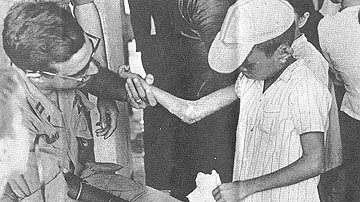 |
Cite Manchus
TAY NINH - The men of Charlie Company, 4th Battalion, 9th Infantry
Manchus were decorated for valorous action against the enemy for the third time
since December.
The 80 medals for valor were presented to Charlie Company in a
ceremony held at Fire Support Base Sedgewick II, for their actions at the battle
of Frontier City, in which the enemy lost 213 men. There was not a single U.S.
loss in that battle.
The medals for that action included four Silver Stars, 38 Bronze
Stars for Valor and 46 Army Commendation Medals for Valor, which brings the 1969
total of decorations for Charlie Company to 234.
First Brigade Commanding Officer Colonel Charles Hayward attended
the ceremony and presented the Silver Stars to Major Harry Ray, Forward Observer
First Lieutenant Kenneth Montoya, Charlie company's commanding officer,
Captain Ramon Pulliam, and First Sergeant Robert Klemach.
Colonel Hayward commended the men on a job well done.
65th Engrs Blow Charlie's Mines
By PFC Larry Goodson
CU CHI - If in the future you see two tractors connected by 100
yards of huge chain moving through the hedgerows, don't worry.
You are witnessing a new type of booby trap disposal put into
operation by the 65th Engineer Battalion at Fire Support Base Pershing, ten
miles northwest of Cu Chi.
The actual equipment consists of two D-7 tractors, four sheets of
3/8 inch metal sheeting, and approximately one hundred yards of anchor chain,
formerly used by an ocean-going vessel.
Used especially for hedgerow clearing, the D-7s move on line
dragging the chains between them and detonating or exposing all boobytraps in
the space.
Armor covers the back side of each driver's seat, as well as the
side facing the area through which the chain is dragged.
According to Platoon Sergeant John E. Mueller, Jr. of Security,
Colo., nearly two days of hard work were required to finish armoring the
bulldozers. Despite the fact that booby traps come in all shapes and
sizes, operator Specialist 5 Anthony Haggard of Los Angeles showed confidence in
his own personal safety by emphasizing that he is riding 50 tons of steel.
"And that's a lot of protection," he added.
Kit Carson Discoverer
By SP4 Art Brown
CU CHI - Warriors of the 2d Battalion, 12th Infantry have a Kit
Carson scout who can practically guarantee the discovery of hidden enemy caches
even if the Viet Cong make a great effort to hide them.
NOAH, AS THE SCOUT is known by his American friends, is almost as
good at collecting enemy weapons as his Biblical namesake was at collecting
animals.
"Noah is almost always the first to discover hidden supplies,"
explained First Lieutenant Mark Breinholt of Provo, Utah. "Just today he
found an AK-47 in a camouflaged hole." The discovery led to others in
the area, and soon the 2d Brigade soldiers had a large collection of enemy
equipment.
"Noah is continually showing us little things that make us more
effective," said Private First Class Charles Boeing of White Plains, N.Y.
"He is serious about his work, too."
"HE DOES HIS share in base camp," added Specialist 4 Larry
Wrightman of Hudson Falls, N.Y. "He's steady, well-liked, and efficient."
Noah speaks little English, but he understands his job so well that
most soldiers working with him for the first time think he can speak English.
For all his past help and his promises of future assistance, the
Warriors rewarded their expert scout with a three-day pass, which permitted him
to visit his family near Trang Bang.
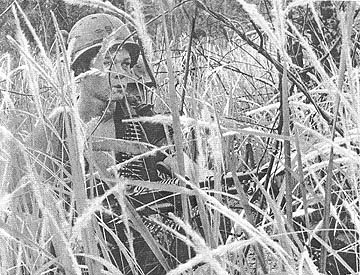 |
IN HIGH GRASS - Private First Class Charles Lokey of Morganhill, Calif., conceals himself and his machinegun in the high grass surrounding Fire Support Base Crook. Lokey is with Bravo Company, 3d Battalion, 22d Infantry. (PHOTO BY SP4 DAVID DEMAURO) |
Page 4-5 TROPIC LIGHTNING NEWS July 14, 1969
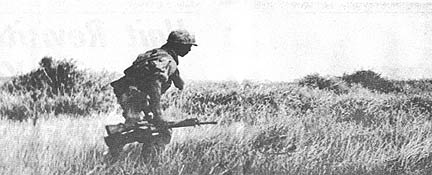 |
|
the rifleman
contributions by
robert williams
|
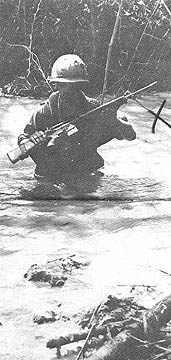 |
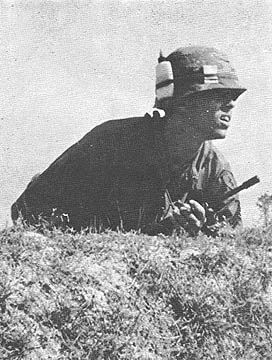 |
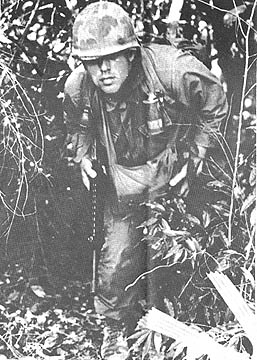 |
|||||
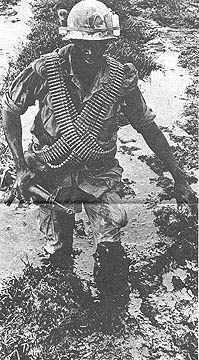 |
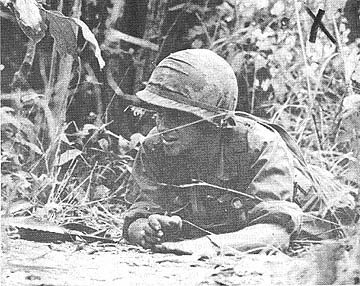 |
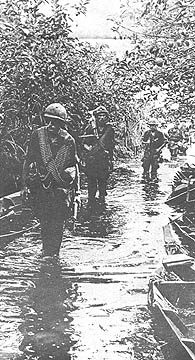 |
|||||
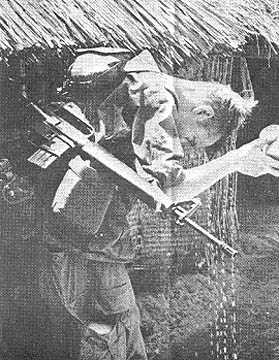 |
|
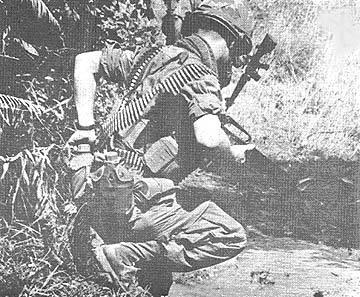 |
|||||
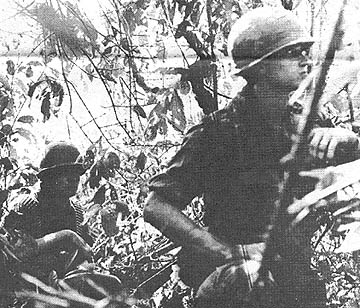 |
Page 6 TROPIC LIGHTNING NEWS July 14, 1969
Love of Man and Beast
By SP5 Rick Adams
DAU TIENG - Love is helping infantry units from the 3d Brigade win
their war against enemy ambushes and infiltration in the rugged terrain 65 miles
northwest of Saigon.
The love is between dog and handler from the scout dog teams that
lead infantry patrols through the rice paddies, heavy jungles and huge rubber
plantations that mark the brigade's battle area.
SPECIALIST 4 JOHN Robinson from Philadelphia, Pa., and his black
Belgian shepherd, Chief, have been leading 3d Brigade patrols for seven months.
"Every dog handler, at one time or another, owes his life to the
alert actions of his dog," Robinson stated when explaining the close
relationship shared by man and his best friend.
"It's very easy for the enemy to hide and surprise you with all
the natural cover in this area," Robinson continued. "It's just you
and your dog, up in front of everyone, so I need all his skill and he needs all
my help."
BESIDES WORKING together, the two live, sleep, eat and play
together. On more than one night ambush, Robinson and Chief have shared a
poncho for protection from a jungle downpour. As he put it, "Dogs are
just like people; if you treat them right, they'll treat you right."
On all missions, the handlers carry a double load of rations -
their own and the dog's. It's C-rations for the soldier and canned
horse meat and burgers for his faithful companion.
"When we're in the field, everything is serious. Chief
knows he's got a job to do, and that I'm going to take care of him," said
Robinson. "But when we're in Dau Tieng, we let our hair down a little
with care-free times and an occasional game of tag."
THE HANDLERS ARE continually improving their dogs. A simple lesson
of shaking hands improves a dog's mental powers. Chief's big trick is
playing dead. "He plays dead better than Lassie," beamed the
20-year-old Robinson.
Robinson even writes home about his constant companion. "My
family knows all about Chief from my letters," he explained. "Every
letter I get from home asks how Chief is - they feel he's almost part of the
family.
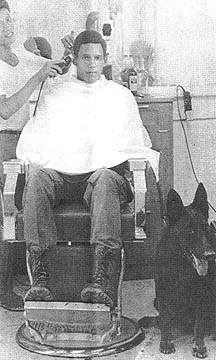 |
CONSTANT COMPANIONS - Specialist 4 John Robinson from the 44th Scout Dog Platoon and his doggy teammate, Chief, stop at the barber shop after a ten day stay in the field with 3d Brigade units. (PHOTO BY SP5 RICK ADAMS) |
Wolfhounds Employ Charlie's Tactics
By SP5 Jack R. Anderson
CU CHI - The mission of American infantry units in Vietnam is to
beat the enemy at their own game. The game is guerrilla warfare.
A tough assignment at best, but one which has been made easier by a
platoon leader who follows a few simple "ambush basics" and uses good old
Yankee ingenuity in bringing unconventional war to an unconventional enemy.
FIRST LIEUTENANT Delbert W. Roe of Grand Prairie, Tex., and his
platoon, "Roe's Raiders", from the 1st Battalion 27th Infantry
Wolfhounds have scored numerous successes by using Charlie's tactics.
"I think our success is due to the excellent training my men have
received, both in the States and in the Wolfhounds ambush school. For
instance, we make maximum use of arm and hand signals and never talk above a
whisper when we're on patrol. Both of those techniques are what you
might call ambush basics. I think our success stems from the effectiveness
of these methods," said Roe.
Roe's platoon can also boast never being spotted by the enemy
first. "If we were spotted, we didn't know it. I'm sure the
silent treatment we have given the enemy was the reason for this. A couple
of times, we've walked up on an enemy observation post and completely
surprised its occupants."
ANOTHER BASIC the platoon has used with success is the art of
camouflage and cover.
"One of my requirements is that my men hide themselves using the
best possible cover where we're set up. We move into an area during
daylight hours and I have the men hide themselves so that I can't see them -
even though it's still light. This way, I'm sure they'll be well
concealed at night," said Roe.
When his platoon is on an operation, it is always the squad that is
opposite the enemy's movement that initiates the ambush. For example, if
troops are moving in from the north, the southernmost squad waits until they are
in the kill zone and then opens up.
Chieu Hoi . . . and then What?
By Major Clarence DeYoung
TAY NINH - Tired, dirty, shaking with disease and fright he could
only say, "Chieu Hoi." Clutched in one grimy fist was a leaflet in
four languages promising safe conduct and good treatment.
Another Hoi Chanh had rallied to the government of the Republic of
Vietnam. With minor variations, this scene occurs every day in the area
covered by the lst Brigade. But this is neither the beginning nor the end.
FOR RALLIER Dao Van Ut, it all began when he was "drafted" by
Viet Cong in Tay Ninh Province. Ut was a farmer, uneducated and poor.
He didn't believe the promises of the local Viet Cong cadre, but when they
told him to be a guerrilla fighter he had no alternative. Ut had a wife
and five children to consider. He had seen too much terrorism to refuse.
After five days of training in the jungles, a cadreman assigned him to a squad
in his home village of Ben Cau. He remained an insurgent for nearly four
months.
The glorious victories promised to Ut and his fellow guerrillas
never materialized. Move all night, dig in, hide from air strikes, fight,
run, bury the dead; the days and nights became one endless cycle until he could
hardly tell what day it was or where he was.
Then he found a leaflet. The message on it was simple; the
front showed a picture of a fatherless family, on the back, the words "chieu
hoi" were simply written. As the guerrillas slipped through tiny hamlets
at night, the moon revealed posters urging "chieu hoi" to their darting
glances.
THE CONSTANT reminders to chieu hoi are not haphazardly strewn
about the landscape. Careful research and targeting goes into each
message. At the 1st Brigade's S-5 Section, careful liaison is maintained
with the Brigade's Intelligence Officer, Major John Bond of Adams, Mass.
Bond passes available intelligence concerning enemy units in the Brigade's
area of operations.
Accurate and timely intelligence is coupled with background
information in the psychological warfare branch of the S-5 section. First
Lieutenant Lesley Witmer of Leola, Pa., develops specific targets for attack and
appropriate themes for use against specific targets. On one mission, the
names of VC in a particular unit who had been killed in battle were broadcast
from a helicopter over the battlefield. Instructions for surrender were
also broadcast.
"The psychological impact on a soldier hearing this during battle
is fantastic," said Witmer, "It literally shocks the fight out of him."
RAPID REACTION leaflets and loudspeaker tapes are prepared by a
field team from the 1st Brigade's 6th PSYOPS Battalion Specialist 5 Justin
Comstock of Grosse Isle, Mich., maintains a stock of standard materials for
immediate dissemination.
One recurring theme in all materials is the appeal to chieu hoi -
to rally to the government of the Republic of Vietnam. The Open Arms Program
gives former VC and NVA soldiers the opportunity to once again become useful
citizens. Training in new job skills, medical treatment, assistance in
finding jobs, reunion with families and loved ones - these are but a few of the
opportunities available to the rallier.
Each new rallier is rapidly processed. Any intelligence
information he may have is taken down. As soon as possible he will be
transferred to a chieu hoi center. At the center, some are given the
opportunity to further serve the cause of freedom.
A NUMBER OF EX-VC and NVA join armed propaganda teams. These
teams go out into small hamlets and spread the word about the benefits of
"switching sides". Others may become Kit Carson scouts and work
directly for American infantry units. Dao Van Ut did this.
Ut had finally reached the proverbial `end of his rope'; he
realized that service with the VC would eventually lead to his death.
Overworked, underpaid, completely disillusioned with the lies of the political
cadre, Ut rallied.
After processing, he was given an opportunity to become a Kit
Carson scout. He did and after using his knowledge and skills in the field
against the Viet Cong Ut was given a chance to further assist.
He was assigned to the S-5 office and became an advisor on VC
matters. Ut checks new material to assure that it will be clear and
comprehensible. When the S-5 prepares for field operations, Ut goes along
to talk to the local Vietnamese.
Page 7 TROPIC LIGHTNING NEWS July 14, 1969
Booby Traps: Watch Your Step
Feature By
SP4 Karl Karlgaard
A group of GIs was walking down a trail recently, well aware that
it had been heavily booby-trapped within the last 24 hours. The order had
been given to keep moving ahead. The Tropic Lightning troopers cautiously
picked their way through the underbrush.
Suddenly the pointman spots a wire - booby trap! Making sure
the next man in the file is aware of the wire, he steps over it carefully.
But as his foot touches the ground, he triggers another booby trap, and the
jungle is shattered by an explosion.
NORMALLY THIS situation would result in several casualties and a
hurried call for a dustoff. But this trail was located in the Mines, Booby
traps, and Tunnel School at the 25th Infantry Division's Cu Chi Base Camp.
The booby traps are noisy, but harmless introductions to Vietnam for fresh
replacements.
The school is located on several heavily vegetated acres of Cu Chi
Base Camp. On this land are booby-trapped trails, a maze of Viet Cong
tunnels, a showcase of captured weapons and equipment, and a special class area.
"We've spent many hours preparing and improving our trails and
tunnels," said Captain William D. Means of Boothbay, Me., head of the
Lightning Combat Training Center.
THE TRAILS ARE the responsibility of Staff Sergeant Tom Kelly of
Long Island, N.Y. Kelly was with the Fifth Special Forces in I Corps
before being assigned to the 25th Division, and is an expert on Jungle warfare.
"I try to booby-trap the trails like the Viet Cong would," said
Kelly. "Only I use harmless noise-producing devices and smoke grenades
instead of the real explosives used by the Viet Cong."
Replacements also receive classes on various types of booby-traps
and explosives they might encounter in the field and are told how to deal with
them. Sergeant Harry Hoechbauer of Downers Grove, Ill., explained, "We
try to show the new men what to look out for in order to stay alive. And
we also show them some of Charlie's favorite hiding places."
THE TRAINING demonstrates to the replacements what to expect and
gives them an idea of operations in booby-trapped areas.
One of the new replacements put his thoughts into words when he
said, "Those trails really teach you to keep your eyes open. I'm glad,
though, that there won't usually be as many booby traps outside the wire."
| SURE IS DARK DOWN THERE - Master Sergeant Edgar Brien of Lanham, Md., peers through a trapdoor to check on students' progress as they move through the tunnel system. | 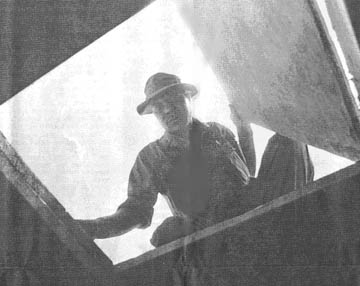 |
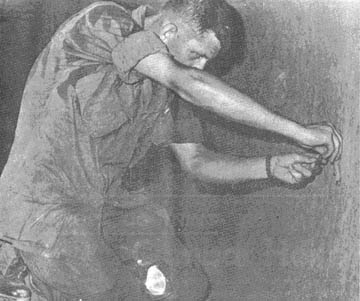 |
TUNNEL TRAP - Sergeant Paul Cook of Superior, Wisc., places a mock booby trap on the wall of a tunnel at the school. Prospective tunnel rats find the school complete with dead ends, seemingly bottomless pits, false walls and ceilings and even a cache of Viet Cong arms and equipment. |
| CU CHI CACHE - Deep in a section of the school's 500 feet of tunnels, Sergeant Paul Cook looks over a cache that is found quite regularly by the school's students. | 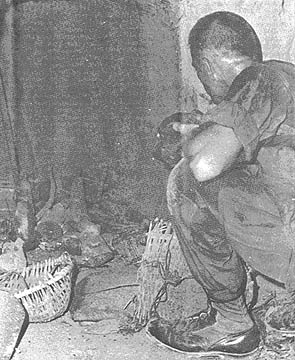 |
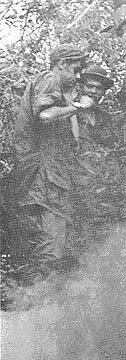 |
WHOOPS - A cloud of dense smoke rises from a booby-trapped smoke grenade as the startled students drop back away from it. Training at the Mines, Booby traps, and Tunnel School gives replacements the realization that they can easily be injured if they are not careful. |
Page 8 TROPIC LIGHTNING NEWS July 14, 1969
Banana Grove Action Flares Again
Tomahawks Trap NVA
By SGT Roger Welt
TAY NINH - Action again centered in a banana grove at the base of
Nui Ba Den Mountain as the 4th Battalion (Mechanized), 23d Infantry met head on
with North Vietnamese soldiers from the 88th North Vietnamese Regiment.
Forty-four of the enemy soldiers were killed by the superior firepower of the
Tomahawks. The total of enemy dead resulting from recent actions amounts
to 157 NVA soldiers.
Lieutenant Colonel G.E. Taylor of Shelby, N.C., the commanding
officer of the Tomahawks, pointed out: "We seem to have caught him in an
awkward spot. He can't get up the mountain, he can't get around it,
and I assure you, that he's not going to come down this side."
The enemy was cornered in the deep caves which pock the craggy
slopes of the "Black Virgin." It probably came as little consolation
to them, short of supplies cut off for more than a week, that there was a banana
grove at their reach full of ripe bananas. The only problem for them is
that the Tomahawks occupy that grove.
As the Tomahawks moved toward the enemy emplacements for the third
consecutive day, they uncovered the bodies of nine more NVA in three hastily dug
graves. The NVA had been killed the previous day by small arms and
automatic weapons fire from the .50 caliber machineguns mounted atop the armored
personnel carriers.
Charlie Company of the 4th Battalion (Mechanized), 23d Infantry
engaged three enemy soldiers as they poked their heads out of a nearby woodline
on the side of the legendary mountain. It proved to be a fatal mistake for
the NVA as the Tomahawks zeroed in on them with accurate small arms fire.
The three were killed and an AK-47 assault rifle was captured.
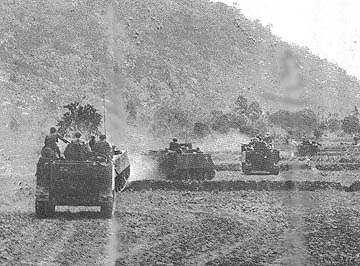 |
ARMORED PERSONNEL CARRIERS from Bravo Company, 4th Battalion (Mechanized), 23d Infantry rumble to the base of Nui Ba Den Mountain to reinforce Charlie Company after heavy contact was made in a banana grove. One-hundred fifty-seven NVA soldiers have died in the action. (PHOTO BY SGT ROGER WELT) |
Hampton Honors War Hero
The heroism of one Tropic Lightning soldier became a part of the
history of a small New England town recently as an American flag was raised over
Hampton Falls, New Hampshire.
The flag, which flew over Fire Support Base Hampton during the
battle there on February 28, had been sent at the direction of the Commanding
General to the parents and grandparents of Sergeant George Evans, killed at
Hampton.
Evans, of Bravo Troop, 3d Squadron, 4th Armored Cavalry, was
mortally wounded as he clung to the top of an armored personnel carrier,
providing covering fire so injured men could be evacuated to safety. He was
posthumously awarded a Silver Star.
The American flag was raised over Hampton Falls on Memorial Day as
a small but very real reminder to the people of the town of the great sacrifices
being made by American soldiers in this war.
In a letter to Major General Ellis W. Williamson, Nathan Young,
Evans' grandfather and a veteran of World War I, wrote: "When I read about
draft card burners and the ones who go over the hill, it is good to know that my
grandson played the game."
49 Enemy Die in Spider Web
By SP4 Frankie L. Ditto
CU CHI - While conducting a reconnaissance-in-force mission in the
"Spider Web" near the Saigon River, Company C, 2d Battalion, 14th Infantry
engaged an unknown size enemy force during a brief exchange of fire.
Thirty-nine North Vietnamese soldiers were killed in the heavy fire laid down by
the Golden Dragons and Vietnamese forces.
AFTER A BRIEF but heavy exchange of fire, Charlie Company pulled
back to allow artillery and helicopter gunships to spray the area. As the
company moved back in to assess the damage, a reactionary force of ARVNs and
Company B sealed off the enemy's routes of exit. A nearby Riverine force
also moved up the river to catch any enemy who tried to leave the area by using
the waterway.
Specialist Four Calvin M. Wyant of Charlie Company was walking with
the point squad when the initial volley of lead was exchanged.
"I MOVED INTO the hedgerow where the NVA had first fired from and
as I crossed a dike, I saw five of them standing beside a bunker. They
were about 75 meters away from me, I opened up and hit one before I headed back
for help," said Wyant.
Contact was broken as the ARVN forces drove the enemy out of his
own bunkers. One hundred B-40 rockets were gathered by the Vietnamese
forces as sniper fire rang throughout the enemy base camp.
| INTO THE BUSHES - A reconnaissance track from the 2d Battalion, 34th Armor moves into the heavy growth with elements from the Vietnamese Regional Forces. The combined operation was conducted near the Saigon river. (PHOTO BY SP5 DOUG ELLIOTT) | 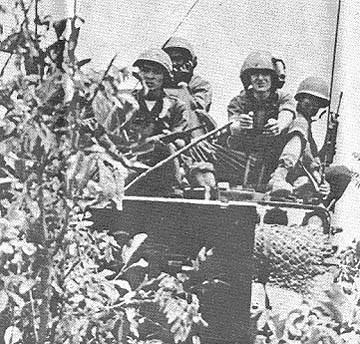 |
Joint Force Sweeps River Banks
CU CHI - In combined operations recently, tanks and recon personnel
of Headquarters Company, 2nd Battalion, 34th Armor joined the 2nd Battalion,
68th Regional Forces Company in sweeps of the Saigon River banks north of Cu
Chi.
Using reconnaissance-by-fire, the combined task force cleared the
area, removing mines and boobytraps. They discovered the bodies of 13
enemy killed in action during the operation.
This was the third operation on which the 2/68th Regional Forces
Company had worked with the Dreadnaught Armor. Lieutenant Colonel Duane R.
Tague of Terre Haute, Ind., commander of the 2nd Battalion, 34th Armor, has nothing but praise for the
Regional Force Company.
"It is a pleasure to work with these outfits. The 2/68th
Regional Forces personnel are aggressive and have a high morale," said Tague.
"Their ability to sniff out boobytraps is a tremendous asset."
Thanks to
Mack D. Gooding, 15th PID, 1st Bde., for sharing this issue,
Kirk Ramsey, 2nd Bn., 14th Inf. for creating this page.
This page last modified 8-12-2004
©2004 25th Infantry Division Association. All rights reserved.